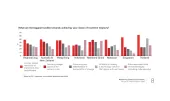Here is the strategic importance of trade finance solutions
By Martin SmithReliable and cost effective Trade Finance solutions are of strategic importance to Asian transaction banks. Both local and foreign operations rely heavily upon relationship positioning within trade customer demographics to develop broader market share growth, improved wallet share, lower customer churn and foster value adding product cross sell opportunities.
East and Partners six-monthly Trade Finance report accurately forecasts demand for trade related banking products and services among institutional businesses constituting Australia’s Top 500 corporations by revenue, corporate businesses with annual turnover of A$20 – 725 million and SME’s turning over A$5 – 20 million. The upcoming twentieth round of research delivers comprehensive historical research upon which trends continue to form and relationships between interconnected Trade Finance metrics are able to be further analysed.
Australian businesses are expected to react favourably to the current low interest rate environment, stimulating export orientated industries that were struggling to adapt to an overvalued Australian dollar. Smaller businesses were finding it increasingly difficult to become more internationalised and competitive due to liquidity and cash flow constraints.
East & Partners latest research has found that insufficient liquidity is cited as the biggest inhibitor of smooth, profitable trade financing transactions. 33.8 percent of institutional customers are seeking more liquidity support, while over three quarters of corporate and SME customers are requesting better cash flow support.
Australian businesses are increasingly offshoring, restructuring or seeking to set-up international supply chain operations in order to build a comparative advantage. Companies face a multitude of challenges based on the geographical locations they intend to export or import their goods and services.
This provides banks with a clearly identifiable penetration point for new product and service offerings. China is the key customer focus for over 52.1 percent of institutional businesses, well ahead of New Zealand which is unsurprisingly the second most popular focus for larger exporting and important businesses in 2013.
India continues to grow as an area of interest, while the USA and Middle East have declined in interest as geographic areas for import and export activity.
Recognising the short term nature of the majority of trade financing dealings and tailoring offerings to institutional, corporate and SME enterprises is an actionable and immediately rewarding approach to championing customer needs. The majority of financial institutions are oblivious to the specific nature of a company’s trade financing requirements, especially in the granular capacity attainable from East and Partners institutional, corporate and SME business depositor segments.
The risk management challenges associated with import-export functions are difficult for CFOs and treasurers to traverse themselves, requiring in depth research and analysis to supplement anecdotal and customer derived feedback.
East’s latest research reveals that smaller businesses have become exasperated with the cross border payments and international transaction banking offerings of the ‘Big Four’ Australian banks, and are open to competitive offerings outside of the heavy weights. Customers seeking trade finance advice are in fact shunning their relationship manager in preference for advice from colleagues, peers and friends. 76.2 percent of institutional enterprises are making trade finance decisions from word of mouth alone, along with 92.4 percent of corporates and a staggering 93.3 percent of SME’s.
There are some positives to be taken from the existing relationships Australian banks have built with institutional sized enterprises. For larger businesses that have developed a strong working relationship with their trade finance manager, bank account lives are lengthening based upon closer ties with their customers.
Reciprocating this approach across corporate and SME sized businesses will result in immediate mind share advantages, which can then be converted to higher market share and wallet share of trade loans, structured trade finance products and e-Trade solutions.
The Big Four have chosen varying approaches to penetrating lucrative Asian banking markets. The one constant remains to be reliance upon building growth from existing relationships in well-established products such as wealth management and trade finance.
The success Australian banks will have in breaking into Asian banking markets is heavily dependent upon how much precedence they place on their trade finance customers product and service experience, both existing and new, across all business segments. ANZ has attained 12.2 percent more trade finance market share and 15.5 percent more wallet share than its nearest competitors, Westpac and HSBC.
In the smaller sized but more populous corporate and SME segments however, ANZ has significant ground to make up on NAB. With the highest market share and wallet share percentages in both these segments, NAB is continuing to set the benchmark for trade financing solutions to smaller sized enterprises in Australia.




















 Advertise
Advertise








